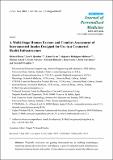| dc.contributor.author | Harte, Richard | |
| dc.contributor.author | Quinlan, Leo R. | |
| dc.contributor.author | Glynn, Liam | |
| dc.contributor.author | Rodriguez-Molinero, Alejandro | |
| dc.contributor.author | Scharf, Thomas | |
| dc.contributor.author | Carenas, Carlos | |
| dc.contributor.author | Reixach, Elisenda | |
| dc.contributor.author | Garcia, Joan | |
| dc.contributor.author | Carrabina, Jordi | |
| dc.contributor.author | Ó Laighin, Gearóid | |
| dc.date.accessioned | 2017-04-03T11:12:36Z | |
| dc.date.available | 2017-04-03T11:12:36Z | |
| dc.date.issued | 2015-12-16 | |
| dc.identifier.citation | Richard Harte, Leo R. Quinlan, Liam Glynn, Alejandro Rodriguez-Molinero, Thomas Scharf, Carlos Carenas, Elisenda Reixach, Joan Garcia, Jordi Carrabina, Gearóid ÓLaighin (2015) 'A Multi-Stage Human Factors and Comfort Assessment of Instrumented Insoles Designed for Use in a Connected Health Infrastructure'. Journal of Personalized Medicine, 5(4), 487-508. | en_IE |
| dc.identifier.issn | 2075-4426 | |
| dc.identifier.uri | http://hdl.handle.net/10379/6421 | |
| dc.description.abstract | Wearable electronics are gaining widespread use as enabling technologies, monitoring human physical activity and behavior as part of connected health infrastructures. Attention to human factors and comfort of these devices can greatly positively influence user experience, with a subsequently higher likelihood of user acceptance and lower levels of device rejection. Here, we employ a human factors and comfort assessment methodology grounded in the principles of human-centered design to influence and enhance the design of an instrumented insole. A use case was developed and interrogated by stakeholders, experts, and end users, capturing the context of use and user characteristics for the instrumented insole. This use case informed all stages of the design process through two full design cycles, leading to the development of an initial version 1 and a later version 2 prototype. Each version of the prototype was subjected to an expert human factors inspection and controlled comfort assessment using human volunteers. Structured feedback from the first cycle of testing was the driver of design changes implemented in the version 2 prototype. This prototype was found to have significantly improved human factors and comfort characteristics over the first version of the prototype. Expert inspection found that many of the original problems in the first prototype had been resolved in the second prototype. Furthermore, a comfort assessment of this prototype with a group of young healthy adults showed it to be indistinguishable from their normal footwear. This study demonstrates the power and effectiveness of human factors and comfort assessment methodologies in influencing and improving the design of wearable devices. | en_IE |
| dc.description.sponsorship | This work was part funded by the EU FP7 project WIISEL (Wireless Insole for Independent and Safe
Elderly Living). Project number FP7-ICT-2011-288878. | en_IE |
| dc.format | application/pdf | en_IE |
| dc.language.iso | en | en_IE |
| dc.publisher | MDPI | en_IE |
| dc.relation.ispartof | Journal of Personalized Medicine | en |
| dc.rights | Attribution-NonCommercial-NoDerivs 3.0 Ireland | |
| dc.rights.uri | https://creativecommons.org/licenses/by-nc-nd/3.0/ie/ | |
| dc.subject | Instrumented insole | en_IE |
| dc.subject | Gait analysis | en_IE |
| dc.subject | Comfort | en_IE |
| dc.subject | Human factors | en_IE |
| dc.subject | Human centered design | en_IE |
| dc.subject | mHealth | en_IE |
| dc.subject | eHealth | en_IE |
| dc.subject | Connected health | en_IE |
| dc.subject | Wearable electronics | en_IE |
| dc.subject | Older adult | en_IE |
| dc.title | A multi-stage human factors and comfort assessment of instrumented insoles designed for use in a connected health infrastructure | en_IE |
| dc.type | Article | en_IE |
| dc.date.updated | 2017-04-03T10:22:11Z | |
| dc.identifier.doi | 10.3390/jpm5040487 | |
| dc.local.publishedsource | http://dx.doi.org/10.3390/jpm5040487 | en_IE |
| dc.description.peer-reviewed | peer-reviewed | |
| dc.contributor.funder | |~| | |
| dc.internal.rssid | 12297745 | |
| dc.local.contact | Leo Quinlan, Dept. Of Physiology, Quadrangle Building, Nui Galway. 3710 Email: leo.quinlan@nuigalway.ie | |
| dc.local.copyrightchecked | No | |
| dc.local.version | ACCEPTED | |
| nui.item.downloads | 436 | |


